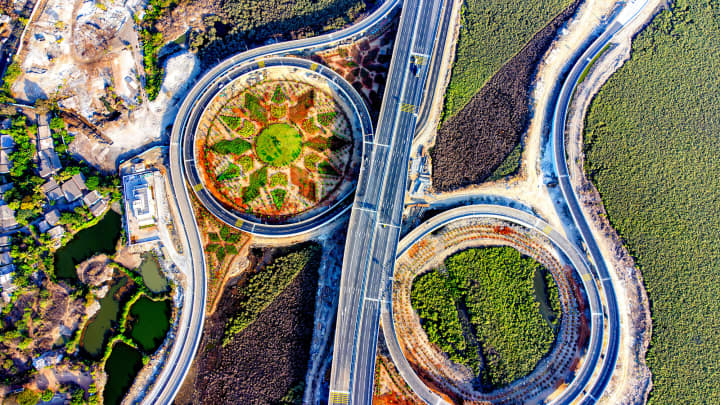
For the last two years, Prime Minister Narendra Modi has spoken confidently about his ambitious goal to .
All eyes will now be on Modi and his Bharatiya Janata Party-led alliance to see if they can keep the economic momentum going and in their third consecutive term in office.
Confidence in the BJP has plunged. Modi's ruling party failed to win an outright majority in the lower house of Parliament for the first time since 2014, and is now forced to rely on its allies in the coalition.
"The government will have to find common ground and build consensus on multiple fronts, not just with alliance partners but also with other stakeholder groups, to push through key legislation in parliament and quell the rising anti-incumbency sentiment nationwide," said Reema Bhattacharya, head of Asia research at risk intelligence firm Verisk Maplecroft.
"A failure to do so could also result in further political setbacks for the ruling party in the next round of state elections scheduled for later in the year," she warned.
A Modi-led coalition won't likely derail India's economic and development, analysts say. However, they point out that the new government will now have to restore faith in the people and ensure India's standing in the Global South remains.
The new government has yet to outline its key priorities. Analysts, however, are predicting that these four areas will feature high on the agenda.
India has undergone a and has made significant strides in connecting and modernizing its highways, railways and airports.
Last year, consultancy firm EY projected that , and highlighted that building up the country's infrastructure capabilities will be pivotal in making this happen.
"Since Modi's been in office, he's done his utmost to build ports, railways, and all kinds of hardline infrastructure to make business fluid. He's going to double down on that," said Samir Kapadia, CEO of India Index and managing principal at Vogel Group.
India still lags China in this area, and more needs to be done if it is seeking high-growth trajectory to continue attracting foreign investors.
At the in February, Finance Minister Nirmala Sitharaman estimated capital expenditure will rise by 11.1% to 11.11 trillion Indian rupees ($133.9 billion) in the fiscal year 2025, largely focused on constructing railways and airports.
But improving connectivity between cities should not be the only area of focus, noted Santanu Sengupta, India economist at Goldman Sachs.
"Along with creating physical infrastructure, India needs to remain steadfast on the structural reforms ... It needs to look at land and unlock land to set up more infrastructure in terms of factories," Sengupta told CNBC, adding that this will drive jobs growth in the sector.
However, analysts highlighted the government might face pushback on this as Modi's weakened hand could make it more tedious to acquire land for projects.
"Such targets may be more difficult if state-level parties have a quasi-veto due to the coalition structure," said Richard Rossow, senior advisor and chair in U.S.-India policy studies at the Center for Strategic and International Studies.
In the past decade, Modi has aggressively pushed for to become Asia's largest manufacturing powerhouse —
U.S. tech giants are increasingly bringing part of their supply chains to India. The that told component suppliers it will source batteries from Indian factories for its upcoming iPhone 16. is also reportedly set to begin by this quarter.
it will ramp up investments in India, while is set to create the first
Projections from Counterpoint Research and the India Electronics and Semiconductor Association show that , a three-fold growth from $23 billion in 2019.
"This will probably be the biggest breadwinner for India over the next five to 10 years," Kapadia said. "Modi firmly believes that if India is able to be in the semiconductor manufacturing business and if he gets it right, India can become an economy that will not be fussed with."
's the world's most populous country is facing, and a mismatch in skills is further exacerbating this issue, Sumedha Dasgupta, senior analyst at The Economist Intelligence Unit said.
"There is already a mismatch between the skill level of the country's workers and the demand for high innovation from employers. This will persist definitely over this decade, possibly into the 2030s as well," she told CNBC.
Unemployment rate in India rose to 8.1% in April from 7.4% in March, according to the
A survey conducted by the Centre for the Study of Developing Societies in April, ahead of the election, showed that for 27% of the 10,000 surveyed. More than half (62%) of those surveyed said it had become more difficult to find a job in the last five years during Modi's second term.
It is now up to the new coalition government to improve local education standards and skills-based training to ensure people are gainfully employed in the right sectors, analysts highlighted.
"While those with advanced education and practical experience are poised to secure jobs in this sector, creating widespread, equitable employment opportunities requires a more inclusive approach," said Vivek Prasad, markets leader at PwC India.
New education policies and vocational training will "engage individuals at all levels of the manufacturing value chain, ensuring that the benefits of economic progress are shared across society," Prasad told CNBC, adding that boosting the employment of women is paramount to driving India's growth.
From veteran emerging markets investor Mark Mobius to global strategist David Roche, market experts remain bullish on India.
The National Stock Exchange of India has a total market capitalization of $4.9 trillion — the third largest in Asia-Pacific, according to data from the World Federation of Exchanges. India's market cap is projected to grow to
Benchmark indexes and the have been strong outperformers this year — respectively rising by 8% and 7% year-to-date, according to LSEG data.
Foreign direct investments into the country needs to however pick up pace to further drive economic growth and development, analysts told CNBC.
Foreign direct investments into India last year were relatively soft due to a difficult private equity funding environment as a result of high U.S. interest rates, said Goldman Sachs' Sengupta said.
"India will likely attract more FDI inflows from the U.S. once interest rates soften and the funding environment becomes easier," Sengupta told CNBC.
Ease of investing in India also "has some ways to go" in order to continue attracting foreign funds, noted Prabhat Ojha, partner and head of Asia client business at Cambridge Associates.
He recommended investors pay more attention to India's banking sector — one that now has good quality growth and capital allocation practices.
"From 2017 to 2019, there was really a cleanup of Indian banks and they are in a very healthy state today," Ojha told CNBC.




